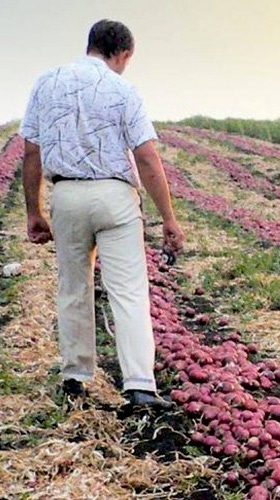Onion Disease Management
Onion Purple Blotch
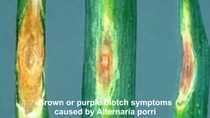
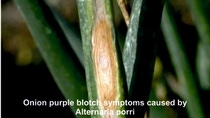
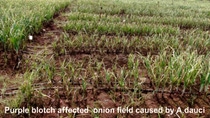
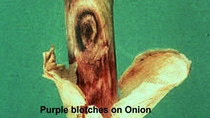
Causal Agent: Alternaria porri (Ellis).
Distribution: Worldwide
Identification:
The disease is characterized by small water-soaked lesions initially on leaves and seed stalk that quickly develop as white centers. As lesions enlarge, they become zonate, brown to purple, surrounded by a yellow zone, and extend upward and downward for some distance. Under the humid condition, the lesion’s surface may be covered with brown to dark gray structures of the fungus. A few large lesions have been formed in a leaf or seed stalk, which may coalesce and girdle the leaf or seed stalks and tissues, distal to the lesions, will die. Usually, the affected leaves or seed stalks fall and die within four weeks if the environment favors the disease. It causes losses of 25% in rabi, 50% in kharif in Maharashtra.
Life Cycle/ Favourable Environmental conditions for the disease:
The disease occurs under favourable conditions of temperature 28-30ºC and 80-90% relative humidity. It is more common in kharif season in Maharashtra. The fungus survives on crop debris on or in the soil for at least a year. Spores of the fungus are produced in the brown to purple blotches and are spread by wind, rain splash and, possibly, by insects. Heavy dews or rains favour the disease, as the leaves need to stay wet for 8 hours for the spores to infect. Older leaves are more susceptible, especially those damaged by the onion thrips.
Control:
- Use a drip irrigation rather than overhead irrigation to avoid long periods of leaf wetness, which assists infection by spores.
- Applications of manure to improve the vigour of the plants will reduce disease severity.
- Harvest when plants are mature, and preferably during dry weather. Cure bulbs before storage.
- Remove plant debris after harvest or incorporate it into the soil so that it decomposes quickly.
- Remove any volunteer onions that develops.
- Do not plant crops of onion one after another without a break; leaves a gap of at least 3 years between consecutive crops.
Stemphylium Leaf Blight
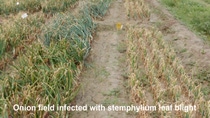
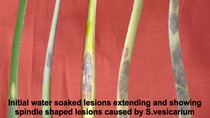
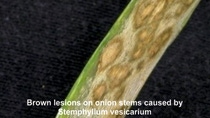
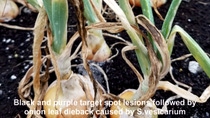
Causal Agent: Stemphylium vesicarium (Wallr.)
Distribution: Worldwide
Identification:
Stemphylium Leaf Blight symptoms on Allium spp. typically become visible 7 to 14 days after inoculation. Early symptoms of Stemphylium Leaf Blight are pale brown to tan lesions that may initially appear water-soaked, are typically up to 2 to 3 cm in diameter, and usually develop first on the outer leaves, or tan, mottled lesions, 0.5 to 4 cm diameter that first develop on inner leaves. Lesions are initially oval-shaped but can become spindle-shaped to ovate-elongate. The centers of the Stemphylium Leaf Blight lesions turn gray or dark olive- brown as profuse production of conidia occurs. In later stages, small yellow flecks or streaks may develop in the middle of the leaf that can progress acropetally to the leaf tips. Some Stemphylium Leaf Blight lesions may also have a pinkish margin surrounding the lesion. Crop loss occurs through reduced photosynthetic area, resulting in smaller, lower the bulbs quality.
Life Cycle/ Favourable Environmental conditions for the disease:
It survives on infected plant debris, and resume thew growth during favorable weather conditions in spring, it then produces spores that are spread to nearby plants by wind. It normally invades dead and dying onion tissue, which as leaf tips, lesions caused by other diseases or simply injured tissues (thrips feeding, or hail). Long periods worm wet conditions encourages the diseases development. Healthy leaves can be attacked if the weather warms (18 to 25 C) and leaf surface is wet for more than 24 hours. Older leaves are susceptible than young ones.
Control:
- Removing or burying the plant debris at the end of the growing season
- Reduce dense planting to have good air flow
- Avoid excessive nitrogen applications which can increases disease severity
- Optimizing thrips management to reduce S. vesicarium secondary spread is also important.
- Do not plant crops of onion one after another without a break; leaves a gap of at least 3 years between consecutive crops.
- Avoid any kind of injury to the plants.
Onion Thrips
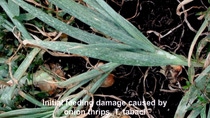
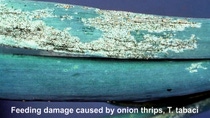
Insect: Thrips tabaci
Distribution: Worldwide
Thrips Damage:
High numbers of thrips can reduce both yield and storage quality of onions. Thrips are most damaging when they feed during the early bulbing stage of onion development. They feed under the leaf folds and in the protected inner leaves near the bulb but may also be found feeding on exposed leaf surfaces when their numbers are high. Their feeding may lead to leaf scarring, which is most serious on green onions. Severe scarring can reduce the effective photosynthetic area and creates an entry point for foliar diseases. Both adults and nymphs cause damage. When foliage is severely damaged, the entire field takes on a silvery appearance.
Life Cycle/ Favourable Environmental conditions for the disease:
Thrips are very small, slender insects that can be easily seen with a hand lens. The most distinctive characteristic of thrips is two pairs of wings that are fringed with long hairs. Adults are pale yellow to light brown. Hot and dry weather can lead to an increase in onion thrips populations and the severity of thrips injury to onion.
Control
- Practice good field sanitation at the end of the season.
- Remove plant debris from previous crops
- Eliminate volunteers.
- Use straw mulch to deter thrips.
Pink Root
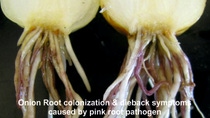
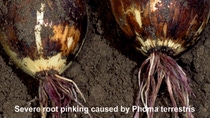
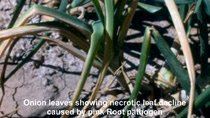
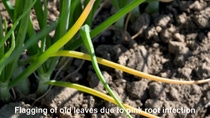
Causal Agent: Phoma terrestris (syn. = Setophoma terrestris)
Distribution: Worldwide
Identification
The disease may appear either in young seedlings or later in the onion's growth. Infected roots turn yellow, then pinkish, then bright pink to red and finally to dark purple as they dry and disintegrate. New roots produced thereafter become diseased and die. Seedlings may die. Otherwise, bulbs lack normal development, are reduced in size and vigor, and have stunted tops.
Life Cycle/ Favourable Environmental conditions for the disease:
The fungus becomes most active during periods when temperatures are between 25 to 300 C and onions grown in fields that are poorly drained are especially vulnerable. The fungus that may survive several years in soil and can also persist in plant debris. When onions or other viable hosts are planted, fungi inoculum migrate to the root surfaces, where they release enzymes which break down tissues and allow the fungi to gain entrance. The rate and severity of infection is often magnified in fields where other pathogens, such as Pythium, have already gained a foothold and have rendered plants more vulnerable.
Control
- A 3- to 6-year crop rotation reduces the severity of infection; however, the fungus still will invade some plants.
- Maintain good crop practices including weed and insect management.
- Adequate watering and proper fertility.
- If disease is observed in the field, immediately remove the affected plants.
- Soil solarization is an effective method of reducing disease.
- Use disease resistant varieties, if available
